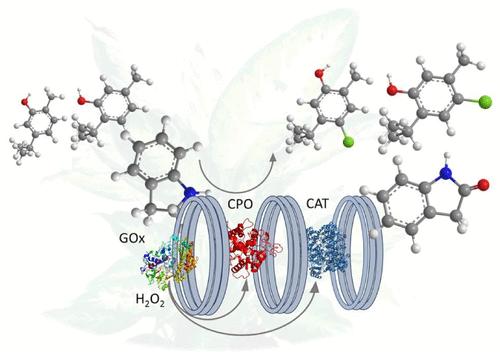当前位置:
X-MOL 学术
›
ACS Sustain. Chem. Eng.
›
论文详情
Our official English website, www.x-mol.net, welcomes your feedback! (Note: you will need to create a separate account there.)
Controlled Delivery of H2O2: A Three-Enzyme Cascade Flow Reactor for Peroxidase-Catalyzed Reactions
ACS Sustainable Chemistry & Engineering ( IF 7.1 ) Pub Date : 2024-06-27 , DOI: 10.1021/acssuschemeng.4c03220 Simin Arshi 1 , Ketan Madane 1 , Kim Shortall 1 , Goran Hailo 1 , Julia Alvarez-Malmagro 1 , Xinxin Xiao 2 , Katarzyna Szymanńska 3 , Serguei Belochapkine 1 , Vivek V. Ranade 1 , Edmond Magner 1
ACS Sustainable Chemistry & Engineering ( IF 7.1 ) Pub Date : 2024-06-27 , DOI: 10.1021/acssuschemeng.4c03220 Simin Arshi 1 , Ketan Madane 1 , Kim Shortall 1 , Goran Hailo 1 , Julia Alvarez-Malmagro 1 , Xinxin Xiao 2 , Katarzyna Szymanńska 3 , Serguei Belochapkine 1 , Vivek V. Ranade 1 , Edmond Magner 1
Affiliation

|
Peroxidases are promising catalysts for oxidation reactions, yet their practical utility has been hindered by the fact that they require hydrogen peroxide (H2O2), which at high concentrations can cause deactivation of enzymes. Practical processes involving the use of peroxidases require the frequent addition of low concentrations of H2O2. In situ generation of H2O2 can be achieved using oxidase-type enzymes. In this study, a three-enzyme cascade system comprised of a H2O2 generator (glucose oxidase (GOx)), H2O2-dependent enzymes (chloroperoxidase (CPO) or horseradish peroxidase (HRP)), and a H2O2 scavenger (catalase (CAT)) was deployed in a flow reactor. Immobilization of the enzymes on a graphite rod was achieved through electrochemically driven physical adsorption, followed by cross-linking with glutaraldehyde. Modeling studies indicated that the flow in the reactor was laminar (Reynolds number, Re < 2000) and was nearly fully developed at the midplane of the annular reactor. Immobilized CAT and GOx displayed good stability, retaining 79% and 84% of their initial activity, respectively, after three cycles of operation. Conversely, immobilized CPO exhibited a considerable reduction in activity after one use, retaining only 30% of its initial activity. The GOx-CAT-GRE system enabled controlled delivery of H2O2 in a more stable manner with a 4-fold enhancement in the oxidation of indole compared to the direct addition of H2O2. Using CPO in solution coupled with GOx-CAT-GRE yields of 90% for the oxidation of indole to 2-oxyindole and of 93% and 91% for the chlorination of thymol and carvacrol, respectively.
中文翻译:

H2O2 的受控传递:用于过氧化物酶催化反应的三酶级联流反应器
过氧化物酶是氧化反应的有前途的催化剂,但它们的实际应用受到了以下事实的阻碍:它们需要过氧化氢(H 2 O 2 ),高浓度的过氧化氢会导致过氧化氢失活。酶。涉及使用过氧化物酶的实际过程需要频繁添加低浓度的 H 2 O 2 。 H 2 O 2 的原位生成可以使用氧化酶型酶来实现。在本研究中,三酶级联系统由 H 2 O 2 发生器(葡萄糖氧化酶 (GOx))、H 2 O 2 依赖性酶(氯过氧化物酶 (CPO) 或辣根过氧化物酶 (HRP))和 H 2 O 2 清除剂(过氧化氢酶 (CAT))部署在流中反应堆。通过电化学驱动的物理吸附,然后与戊二醛交联,实现了酶在石墨棒上的固定化。模型研究表明,反应器中的流动是层流(雷诺数,R e < 2000),并且在环形反应器的中平面处几乎完全发展。固定化的CAT和GOx表现出良好的稳定性,在三个操作周期后分别保留了其初始活性的79%和84%。相反,固定化 CPO 在一次使用后活性显着降低,仅保留其初始活性的 30%。 GOx-CAT-GRE 系统能够以更稳定的方式控制 H 2 O 2 的输送,与直接添加 H 相比,吲哚的氧化增强了 4 倍 2 O 2 。 使用溶液中的 CPO 与 GOx-CAT-GRE 结合,将吲哚氧化为 2-羟基吲哚,产率分别为 90%,百里酚和香芹酚的氯化产率分别为 93% 和 91%。
更新日期:2024-06-27
中文翻译:

H2O2 的受控传递:用于过氧化物酶催化反应的三酶级联流反应器
过氧化物酶是氧化反应的有前途的催化剂,但它们的实际应用受到了以下事实的阻碍:它们需要过氧化氢(H 2 O 2 ),高浓度的过氧化氢会导致过氧化氢失活。酶。涉及使用过氧化物酶的实际过程需要频繁添加低浓度的 H 2 O 2 。 H 2 O 2 的原位生成可以使用氧化酶型酶来实现。在本研究中,三酶级联系统由 H 2 O 2 发生器(葡萄糖氧化酶 (GOx))、H 2 O 2 依赖性酶(氯过氧化物酶 (CPO) 或辣根过氧化物酶 (HRP))和 H 2 O 2 清除剂(过氧化氢酶 (CAT))部署在流中反应堆。通过电化学驱动的物理吸附,然后与戊二醛交联,实现了酶在石墨棒上的固定化。模型研究表明,反应器中的流动是层流(雷诺数,R e < 2000),并且在环形反应器的中平面处几乎完全发展。固定化的CAT和GOx表现出良好的稳定性,在三个操作周期后分别保留了其初始活性的79%和84%。相反,固定化 CPO 在一次使用后活性显着降低,仅保留其初始活性的 30%。 GOx-CAT-GRE 系统能够以更稳定的方式控制 H 2 O 2 的输送,与直接添加 H 相比,吲哚的氧化增强了 4 倍 2 O 2 。 使用溶液中的 CPO 与 GOx-CAT-GRE 结合,将吲哚氧化为 2-羟基吲哚,产率分别为 90%,百里酚和香芹酚的氯化产率分别为 93% 和 91%。
















































 京公网安备 11010802027423号
京公网安备 11010802027423号